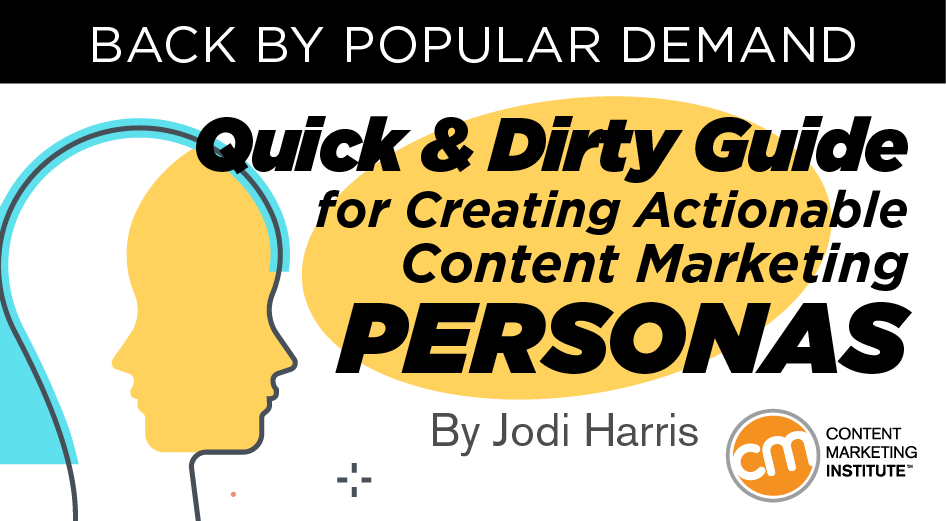Author: Jodi Harris / Source: Content Marketing Institute

Editor’s note: You may have missed this article when CMI published it in 2015. We’re publishing this update because well-crafted personas are so essential to successful content marketing.
“Personas? I already know who my audience is, so do I really need to create one more document that no one will likely use?”
Like all content marketers, you are probably crunched for time and always looking to trim unnecessary processes. But you shouldn’t think of personas as one of those nice-to-have tools abandoned as soon as you build them. Having documented personas, even in their simplest forms, will not only help you crystallize your ideas, but also serve as a single version of truth for everybody creating content for your organization.
If you are like the 68% of B2B and 73% of B2C marketers who are focused on building audiences as part of their content marketing strategies, stay tuned. I’m here to take the stress out of persona development – and help make them as practically useful as possible. Read on to learn the essential steps for creating and applying content marketing personas more successfully.
What are personas, and why do you need them?
As defined by Ardath Albee, a persona is a composite sketch of a target market based on validated commonalities – not assumptions – that informs content strategy to drive productive buyer engagement (i.e., revenue).
Without personas, you may only guess what content your audience wants, which means you are more likely to revert to creating content around what you know best (your products and company) instead of around the information your audience is actively seeking.
Furthermore, you personally may have a handle on this information, but does everybody creating content in your organization have that same vision of your ideal audience? Documenting your personas, even if done quickly, is key to keeping everybody focused on the same audience.
Actionable personas go beyond the demographics
When you think of your audience, you may first think in business demographic terms. Naturally, you want your personas to include the most relevant data points (e.g., business type, job title and function, geographic location). However, while this data is used primarily to group audience members by what they have in common, personas enable marketers to hone key differentiators that, once revealed, could give your company’s content an edge. Even for time-crunched content marketers, anything that can help you to prioritize the most competitively relevant and strategically aligned insights should be considered invaluable.
Constructing your personas
Persona development is a customized process, as it is meant to help your team address its unique marketing challenges and opportunities. However, the following framework can help you get started on the right track:
Step 1: Envision your ideal customer.
This should be the person your content efforts are likely to help most. To build a picture of who she (or he) is, give the person a name and fill in the most critical characteristics relevant to your business. This character sketch will serve as the foundation of your persona.
- Who is she? What demographic characteristics describe her?
- What’s her job title and function?
- What kind of company/industry does she work in?
- How long has she been serving in this capacity within the organization?
- What experience/expertise does she bring to this role?
- How does her job relate to the job of others in her department, and other departments in her organization?
Step 2: Consider the specific objectives, responsibilities, and obstacles she might encounter regularly in performing her role.
For example:
- What goals does she need to accomplish to be successful in her job?
- What challenges frustrate her most about her job?
- What needs gaps might she be looking to fill or what specific problems would she need to solve to alleviate some frustration?
- What might keep her from addressing those gaps/problems?
TIP: Once you have a basic character sketch of who your persona is and what her most pressing goals and challenges are, it may be helpful to create some day-in-the-life snapshots – brief statements that can illustrate what life is like in her (work) shoes. In her presentation at the 2016 Intelligent Content Conference, Ardath explained that these scenarios can help you humanize your persona. She recommends using the voice of the persona in your scenarios and speaking in plain language to give your content team a relatable picture of who she is and what she might be looking for help with (as you can see in Ardath’s example):

Another way day-in-the-life scenarios can be helpful is that they provide a clearer view of your persona’s relationships to other members of the “buying committee” – i.e., the people/teams within an organization who are involved in making purchasing decisions for the company.
Answering questions like the following can help you focus on important clues about the best way to approach content conversations with her – and uncover other stakeholder personas you might need to target:
- How influential is she in her company’s decision-making process? Where might pushback come?
- Who else might influence her decisions (internal and external)?
- Does she need others to sign off on her decisions?
- How far along is she in her consideration process?
- What questions is she likely to ask to satisfy her criteria for making…
Peter Bordes Jr
Founder & Managing Partner Trajectory Ventures. Lifetime entrepreneur, CEO, Board Member, mentor, advisor and investor.
Obsessed with the infinite realm of possibility in disruptive innovation driving global digital transformation in technology, cloud-based infrastructure, artificial intelligence, data, DevOps, fintech, robotics, aerospace, blockchain and digital media and advertising.

